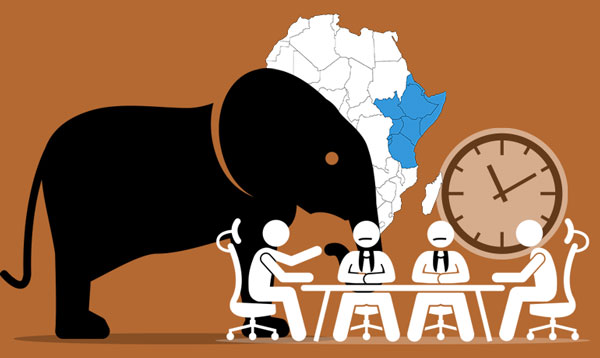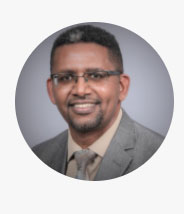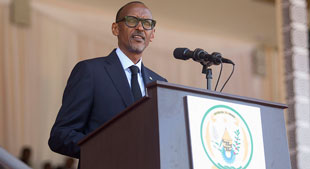
The Elephant in The Room: What is behind the stalled GERD negotiation and how should it move forward?
COMMENT | DR TIRUSEW ASEFA | Every roadblock in the tripartite negotiation between Egypt, Ethiopia, and the Sudan leads to one issue: Nile water use allocation. Both Egypt and Sudan are adamant on showing even a hint of flexibility, sticking to their proposition in the 1959 colonial agreement between the two countries that granted them 100% utilization of the Nile water. Dr. Salman M.A. Salman, an expert in water and law and Editor-in-Chief of Brill Research Perspectives in International Water Law, sees the problem with this agreement starting from its title which says “…full utilization of the Nile.” This is at the expense of the rest of the Nile basin countries who are responsible for the “full” supply of the Nile water. Even more so at the expense of Ethiopia who generates 86% of the total Nile flow. Ethiopia finds its zero percent water allocation as a nonstarter no matter how it is packaged: whether it is called “benefit sharing,” “extended drought release” “existing water use,” or “an existential threat caused by any reduction.”
A recent weASPiRE webinar that I hosted among four international experts on water, economic, law, and policy raised this very problem as a core issue for stalled negotiating between the three countries.
As it stands, both Egypt and Sudan are insisting on a “binding agreement” before Ethiopia starts the second year of the Grand Ethiopian Renaissance Dam (GERD) filling at 13.5 BCM this summer. This filling is part of the GERD construction that was agreed upon by the three countries making it almost impossible not to hold water because of its link with construction of the central block of the dam. Once the central block of the dam is raised, more water will be coming into the GERD during the summer rain that can not get “unheld.” The issue is not whether there is enough water in the basin this summer (given that the High Aswan Dam’s current level is still at 20-year high and river flow is projected to be at an above average flow condition); it is rather how the operation of the GERD would look like in the future. The ultimate goal seems to be to impose a “binding” zero allocation to Ethiopia.
Should the GERD filling agreement be decoupled from long-term operation?
There are many independent experts including the European Union that found it problematic to push for a “binding agreement” for the GERD’s operation as Egypt and Sudan are insisting without addressing the underlying water allocation issue. For example, the EU while supporting the African Union’s (AU’s) leadership notes the first filling can be addressed to everyone’s satisfaction and adds “the operations after the filling need further discussions to reach a water sharing arrangements, as occurs in all river basins.”
This is the same sticky situation that resulted in a no-solution agreement by the so-called US-World Bank mediation back in the fall of 2019. In that draft document, Egypt asked for a “binding” release scenario that effectively cuts the GERD’s ability to produce power by one-third and greatly diminishes the chances of filling the dam. Dr. Salman sees this as the single most critical issue that has been in discussion between the three countries for more than a decade with no breakthrough yet. He says, “you can do the filling and operation [discussion]… and at the same time… raise the issue of water allocation.” Dr. Marc Jeuland, a professor at Sanford School of Public Policy, sees the water sharing issue as a prerequisite to get to a permanent binding water release agreement during the GERD operation. Without acknowledging and figuring that out, it will be difficult to get to a place that is acceptable by all parties. The water sharing issue of who gets how much is a key way to get out of this stalled negotiation. Dr. Jeuland asks whether you need the water rights to be cleared to devise a long-term operation strategy. He thinks you do. “There needs to be some discussions about what those rights are,” he stated.
Who is responsible for drought management?
One of the contended points in the negotiations between Egypt and Ethiopia is the priority of dam filling between the High Aswan Dam (HAD) and the GERD after an extended drought. Egypt insists Ethiopia should release a certain amount of flow beyond what Ethiopia has already committed, which is the flow that would have occurred without the GERD, plus additional storage. Egypt insists these releases should be in place regardless of changes in future hydrologic conditions (including potential flow changes because of climate change or upstream water use) effectively putting the task of water supply during periods of drought and its management solely on Ethiopia. Ethiopia says it is not responsible for all the problems that could be created by mother nature. A complicating factor is the lack of a water sharing agreement that could be executed during this kind of scenario which would enable Ethiopia to use its share to fill its dam in a future scenario.
Dr. Upmanu Lall, who is the director of Columbia Water Center at Columbia University, says that is exactly the issue, “in the absence of a sharing agreement, how do you actually bring these [countries] to the table? You can spend years negotiating an agreement and the terms of that agreement would have to include every contingency with regards to different kinds of drought. That’s a nonstarter in a way.” Many observers point to the lack of Egypt’s willingness to the use of alternative water sources during drought time as well. During such extreme cases, for example, Egypt could tap into its vast groundwater sources or diversify its resources by tapping into desalinated water which over the years has come to be much cheaper than what it was just a decade ago. Framing the solution for all water shortage in Egypt to surface water coming from Ethiopian highlands misses what water resources managers could do to manage extremes droughts, specifically conjunctive water use. “It is not like as soon as there is less water, there is no option anymore. There are options. Maybe tapping groundwater that you don’t typically use could be the solution during this extreme drought,” says Dr. Jeuland.
There is also a creative solution in terms of insurance instruments that could come into play to tackle unforeseen extreme drought situations according to Dr. Lall. Our experience shows the so-called VarQ operating regime in the Columbia River agreement between the US and Canada can be used as an example where additional drought-time release deemed necessary and may not be part of the initial agreement can be accommodated. In such instances the dam owner could be compensated to operate in a way that can help downstream countries overcome unexpected circumstances. Questions that can be considered are: “If you think that [drought] is a shared risk, in terms of securitization strategy how much money would you like to receive if the flow drops below a certain level and how much are you willing to pay for it?” This approach could be one way to manage extreme droughts that have a small chance of occurring but can have serious consequences. “Both Egypt and Ethiopia can then independently decide for themselves and negotiate the terms of the insurance” adds Lall. But a successful application of such an approach would depend, again, on prior water sharing agreement among Nile basin countries, which is non-existent today.
Do Egypt, Ethiopia and Sudan need more mediators to get to a solution?
Recently Sudan proposed to add more mediators to the tripartite negotiation. This includes the United Nations, European Union, and the USA, in addition to the African Union which currently leads the effort. It is to be noted that the last time a third party tried to mediate between these countries (US/World Bank), they ended up writing what many call a one-sided draft document that was thought to be heavily tilted towards Egypt. The former US Ambassador to Ethiopia, Mr. David H. Shinn said at the time “the United States seems to be putting its thumb on the scale in favor of Egypt.” Ethiopia walked out of that negotiation. There are many who say the role of a third-party facilitator is to provide ideas, data, new ways of framing the issue, and knowledge from similar experiences outside the present matter that enable the parties to sustain engagement and eventually reach an agreement. Other than that, the parties must come to agreement by themselves. That is the only way toward sustained solution. Prof. van der Zaag, of IHE Delft in the Netherlands, cautioned against approaches that involve outsiders which may result in direct conflict to the stakeholders’ benefits, lack a local perspective, and may even be against the parties’ interest. Under such a scenario, he says, “donors become part [of the problem] and add more complexity. You cannot, as an outsider, make parties agree.” This is a similar sentiment reflected by Dr. Salman, stressing “the presence of more than one mediator could end up being a complicating factor [rather] than facilitating one.”
Where do we go from here?
One thing that is clear from my panelists is there is a way forward that could potentially be a win-win solution. But some parties may need “out of the box” thinking and have a willingness to see the big picture with regards to what works for all countries in the region. “The most important thing is to focus on what a joint vision of the future looks like, a positive vision that you would like to achieve across these countries and [figuring out] how the water story fits into that rather than driving from how do we negotiate the water” first, says Dr. Lall. Concentrating on what each country gains rather than what it perceives to be losing is another way to look at it according to Salman. He says “They need to try to find out first what can Egypt get out of this dam, what can Sudan get out of this dam. Concentrate on that. Build on that. Strengthen that and it will be a major step in helping the mediating effort.”
The key to achieving collaboration among these countries, according to Jeuland, is “depoliticization” of the whole process to get to a cooperative framework. He also sees that concentrating on institutions and trust to generate this mutual benefit are more important than cubic meters of water. There is ample evidence from around the world where this resulted in positive outcomes rather than conflicts. Dr. van der Zaag advises this discussion needs to take out the emotion including reporting by journalists who tend to sensationalize things as no one chooses their neighbors. These countries will be living together and need to think about the next generation to get the best out of the resources they have.
The message is that there is more to gain by all three countries through cooperation than concentrating on a single country’s benefit.
A starter will be acknowledging the share and the right of utilization of the Nile water by both upper and lower riparian basin countries. Every challenge to the negotiation between the tripartite states so far leads to one problem: water allocation. While the Egyptians say it is not about water allocation and just about the GERD, the elephant in the room is a water allocation issue that needs to be addressed to get to a permanent “binding” agreement which everyone will be happy to accept.
****
 This article was first published in weApire in March 2021. Dr. Tirusew Asefa is a registered professional engineer with the State of Florida, a Diplomate of the American Academy of Water Resources Engineers, and a Fellow of the American Society of Civil Engineers. He currently chairs Florida Water and Climate Alliance. He can be reached at mululove@yahoo.com
This article was first published in weApire in March 2021. Dr. Tirusew Asefa is a registered professional engineer with the State of Florida, a Diplomate of the American Academy of Water Resources Engineers, and a Fellow of the American Society of Civil Engineers. He currently chairs Florida Water and Climate Alliance. He can be reached at mululove@yahoo.com
 The Independent Uganda: You get the Truth we Pay the Price
The Independent Uganda: You get the Truth we Pay the Price


